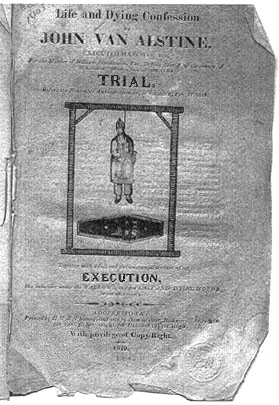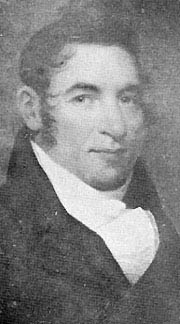 |
on Executions by Hanging in New York State (Page 9: 1818 - 1819) |

|
With links to more information on selected cases.
Open | Close
|
Can you fill any data gaps? Please e-mail webmaster Thomas C. McCarthy at NYCHS@nyc.rr.com | |
| 1818 | A white male named Abraham Casler was hanged on May 29 for murder.
According to Jeptha R. Simms' History of Schoharie County on the Schoharie County NYGenWeb Site, Casler's 1818 execution was the Schoharie's first for a capital offense after the county's formation April 7th, 1795. A Mrs. Best, an innkeeper's wife, gave testimony supportive of the prosecution's case that Casler administered opium and arsenic to Mrs. Casler while the Montgomery County couple stayed at the Bests' inn on a journey through Schoharie County. Apparently Casler wanted his wife out of the way in order that he might marry another woman who had become the object of "his unholy desires." [Simms, Ch. XX] According to William E. Roscoe' History of Schoharie County on the Schoharie County NYGenWeb Site, Casler had married a Miss Spraker but "his immorality and love for another woman" made the home situation unpleasant. Pretending repentance, he persuaded his wife to journey with him by wagon to start anew elsewhere. At the Bests inn on the road from Punchkill to Middleburgh, Casler attended to his wife who complained of feeling ill. Her family who had not been told of her illness became suspicious after Casler suddenly disappeared following the burial. The body was exhumed. Examination detected the opium and arsenic. Tried and convicted Sept. 12, 1817, before "Judge Yates," Casler was publicly executed on the hill east of the courthouse the following May.
A soldier named James Hamilton was hanged on Nov. 6, 1818 for murder. According brief entry descriptions for an August 1818 story in the Detroit Gazette and for October and November 1818 stories in the Cherry Valley Gazette (Otsego County), major Benjamin Birdsall died Sunday, July 14, 1818, having been shot by James Hamilton, "an Irishman." The major had been with the U.S. Rifle Corps and was survived by a wife and four children. Hamilton was convicted at a trial in Albany County Court of Oyer and Terminer in October and executed the next month.
|
||||||
1819 |
Jeptha R. Simms in his History of Schoharie County on the Schoharie County NYGenWeb Site and David Minor on his excellent Eagles Byte Historical Research site both provide very readable accounts of the case.
The most detailed report to be found on the web is the transcription of a "12 1/2 cts" pamphlet that its 1819 publisher, H. & E. Phinneyen of Cooperstown, titled:
Life and Dying Confession of John Van Alstine EXECUTED MARCH 19, 1819 For the Murder of William Huddleston, Esq. Deputy Sheriff of the county of Schoharie. With a full account of his TRIAL, Before the Honorable Ambrose Spencer, in Schoharie, Feb. 17, 1819 Together with a full and circumstantial account of his EXECUTION, His behavior under the GALLOWS, and his LAST AND DYING WORDS to the spectators.
The booklet opens with a copyright statement signed by Richard R. Lansing, Clerk of the Northern District of New York, to the effect that "on the 18th day of March, in the 43rd year of the Independence of the United States of America, A.D. 1819, GILES H. HUBBARD, of said District, hath deposited in this office the title of a Book, the right whereof he claims as Author and Proprietor in the words and figures following, to wit: A Life and dying confession of John Van Alstine, executed March 19, . . ."
That would mean Hubbard filed the copyright claim for the "dying confession" book the day BEFORE the execution!
Perhaps Hubbard was just getting a headstart by describing as a "dying confession" the words in the book attributed to Van Alstine. Regardless, the text makes fascinating reading, not merely for details about the case, but also for conveying the temperment of the times.
Indicted in November, 1818, Van Alstine was arraigned at a special Oyer and Terminer, held at the Schoharie courthouse Feb. 16, 1819, and pled "Not Guilty." The trial began Wednesday morning, Feb. 17, before Chief Justice Ambrose Spencer. Also present were Judges Beekman, Bouck, Shepherd, Shafer, and Hager. At the prosecution table were District Attorney Henry Hamilton
and Moses I. Cantine, Esq. The defense attorneys were Jacob Gebbard and Thomas J. Oakley.
The testimony of each of the dozens of witnesses for and against was summarized in the booklet. While no one testified to seeing the killing, witnesses established
The jury returned a guilty verdict at 5 P.M. the same day. Judge Spencer the next day, while sentencing the defendant to be hanged in the early afternoon of March 19, 1819, recalled that only nine months earlier Abraham Casler had been executed in the county. The judge, out of consideration for Van Alstine's family, said he would not order his body disected.
The next section of the pamphlet, an apparent autobiographical sketch by Van Alstine in the first person, described his life and events involved in the case. The booklet's closing section detailed the execution. It told how:
So who was Giles H. Hubbard, author of the 1819 Life and Dying Confession of John Van Alstine pamphlet that Kit Crumpton transcribed and posted on the Schoharie County NYGenWeb Site?
Who was the author so close to the execution scene that he could hear and recall even the words the prisoner addressed only to the sheriff? Would you believe the author was the sheriff? Well, according to Chapter IX of William E. Roscoe' 1882 History of Schoharie County on the Schoharie County NYGenWeb Site, Giles H. Hubbard and his brother Aaron settled at the beginning of the 19th Century in that part of Schoharie County which became known as Smithtown.
Giles, a graduate of Union College, had fitted himself for the law, but succeeded Abraham Keyser as County Sheriff on Feb. 9, 1819; that is, a month before Van Alstine was to be executed. Giles H. Hubbard served as sheriff until February 12, 1821. Aaron was elected to the Legislature in 1816, 1817, and 1819.
On April 16, 1819, two white males James Teed and David Dunning were hanged for murder. According brief entry descriptions for 1819 stories -- March, April and May -- in the Cherry Valley Gazette (Otsego County), James Teed and Richard Dunning were accused in the death of a Richard Jennings. They were tried at Orange County Oyer and Terminer Court in Goshen along with Hannah Teed, David Conklin and Jack Hodges, the latter an African-American. Apparently, the men were convicted and sentenced but only James Teed and David Dunning were executed.
On Aug. 6, 1819, a 60-year-old white man named Nathan Foster was hanged for the murder of his wife. He was charged with poisoning her. The Masonville resident was tried in the Delhi courthouse. Erastus Root and Samuel Sherwood were the attorneys for the defendant. Both later became U.S. Representatives. Root also became a NY State Assemblyman, Assembly Speaker, State Senator, State Constitutional Convention Delegate, and Liuetenant Governor. The Delaware County district attorney was assisted in the prosecution of the case by NY State Attorney General Martin Van Buren, the future 8th President of the United States. As explained at length in this Timeline's Page 8 entry for the 1817 Margaret Houghtaling execution, a state attorney general or an assistant state attorney general might found at the prosecution table, along with the local district attorney, trying a capital murder case in most any one of the counties of New York during much of the 19th Century.
Delaware County Sheriff Martin Keeler of Kortright supervised the the carrying out of the death sentence. Foster was executed without ever confessing guilt. Interestingly, the 19th Century Delaware County historians whose works, transcribed and posted on genealogy and history web sites, including the Delaware County NY Genealogy and History Site, mention the Foster case seemed more focused on a murder for which he was never formally charged. David Murray, W.W. Munsell and Jay Gould's separate histories of the county each devoted more attention to the tenuous connection of Foster to the death of Colonel Ichabod Alden during the Cherry Valley massacre four decades earlier than to the proven poisoning of Mrs. Foster. Resentment against Foster for allegedly having been a Tory during the Revolution flamed anew with the wife murder case. To some, it may have possibly looked like a chance to right an old wrong while also righting a new wrong. Murray and Gould's histories repeated a third-hand report implicating Foster in the death of Alden during an Indian attack on a Patriot fort that the Revolutionary colonel commanded. Munsell also repeated the hearsay -- quoting someone quoting someone supposedly quoting Foster -- but, to Munsell's credit for balanced reporting, he also noted that historian Colonel William L. Stone in his book on the Native-American pro-British warrior Brant, attributed Col. Alden's death "to an Indian."
On Oct. 22, 1819, a white seaman named George Brown was hanged for murder.*
While web searching turned up nothing about a seaman George Brown being hanged in October 1819 for murder in New York, the curious coincidence did surface: A pirate named George Brown, captured by a federal cutter out of New Orleans, was hanged in Galveston Bay in October 1819.
On Dec. 3, 1819, a soldier named John Godfrey was hanged for murder.* |
|
Back to Page 1: 1779 - 1784
Back to Page 2: 1785 - 1791 Back to Page 3: 1792 - 1794 Back to Page 4: 1795 - 1801 |
Back to Page 5: 1802 - 1806
Back to Page 6: 1807 - 1812 Back to Page 7: 1813 - 1815 Back to Page 8: 1816 - 1817 |
More 'Timeline on NYS Executions' under construction.
To |
To Executions |





